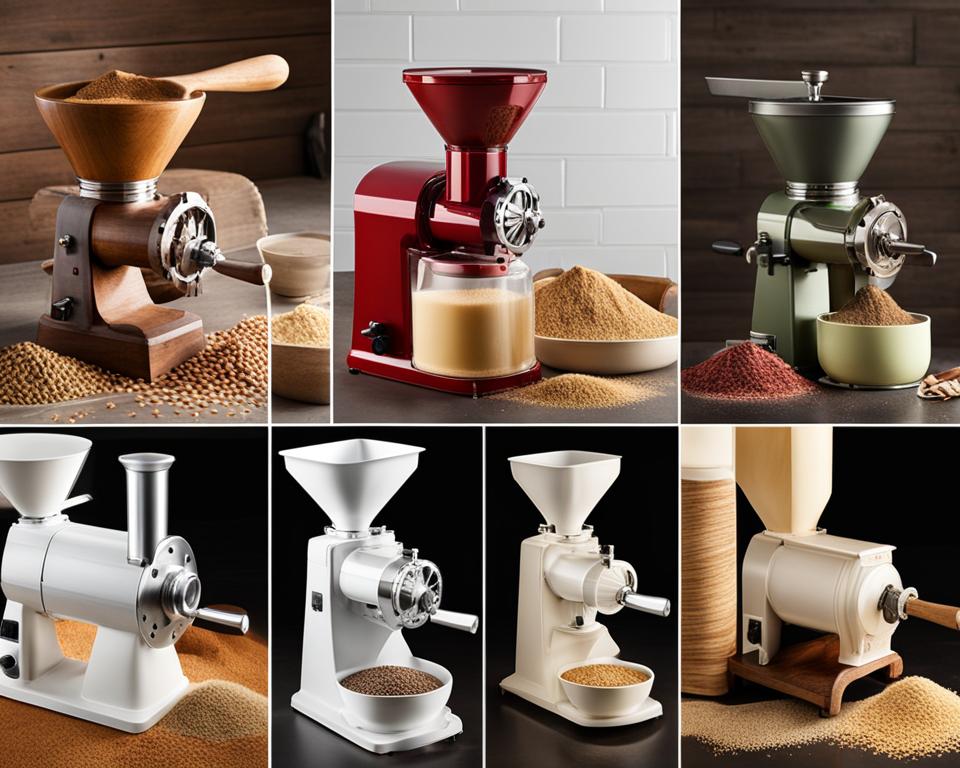When it comes to choosing a rice grinding machine, there are several factors that need to be considered. Whether you’re a professional chef or a home cook, finding the right machine can make a significant difference in the quality and texture of your rice dishes. In this buying guide, I will walk you through the important factors to consider and provide insights to help you make an informed decision.
One of the key factors to consider is the type of milling mechanism. Different types of machines offer varying levels of versatility and performance. Quality stone burr mills, for example, are known for their ability to produce fine flour from a variety of grains, including rice. On the other hand, impact mills offer high-speed performance but are limited to producing flour only. Steel burr grain mills provide a wide range of adjustability and can grind grains to an ultra-fine texture.
Another important consideration is the power source and operation method. Electric, hand crank, and combination options are available, depending on your preference and power source availability. Think about whether you prefer the convenience of an electric machine or the control of a hand crank.
It’s also crucial to evaluate the specific needs of your kitchen. Are you using the machine for home use or in a commercial setting? Consider the milling speed and capacity of the machine to ensure it meets your production requirements.
By carefully considering these factors, you can find the perfect rice grinding machine that will suit your needs and produce high-quality rice. This buying guide will equip you with the knowledge to make an informed decision and unlock the full potential of your kitchen.
Understanding Grain Mill Designs and Types
When it comes to grain mills, there are various designs and types available, each with its own unique characteristics and abilities. Understanding these options can help you make an informed decision when choosing a grain mill that best suits your needs.
Stone Burr Grain Mills
Stone burr grain mills are known for their versatility and ability to grind various dry grains and beans. They offer a wide range of texture options, allowing you to achieve different levels of coarseness or fineness in your flour. Stone burr mills are also prized for their cool-grinding feature, which helps retain the nutritional value and flavor of the grains. With their long burr life, these mills are built to stand the test of time.
Impact Grain Mills
Impact grain mills, also known as micronizers, use high-speed spinning to burst grain kernels into small pieces. These mills are electric-only and are capable of producing flour of varying coarseness. While they offer high-speed performance, they are limited to producing flour and do not have the versatility of stone burr grain mills.
Steel Burr Grain Mills
Steel burr grain mills combine the versatility of stone burr mills with the durability of steel. These mills offer adjustable texture options, allowing you to grind grains to a fine flour or a coarser texture. Steel burr grain mills are available in both hand-crank and electric models, providing options based on your preference and power source availability.
Stone burr grain mills provide a wide range of texture options and are known for their cool-grinding feature, while impact grain mills offer high-speed performance. Steel burr grain mills combine versatility and durability, with options for both hand-crank and electric models.

| Grain Mill Design | Characteristics | Capabilities |
|---|---|---|
| Stone Burr Grain Mills | Versatile, cool-grinding, long burr life | Grind various dry grains and beans to different texture options |
| Impact Grain Mills | High-speed performance | Produce flour of varying coarseness |
| Steel Burr Grain Mills | Versatile, durable | Adjustable texture options, available in hand-crank and electric models |
By understanding the different grain mill designs and types, you can choose the one that best fits your needs and preferences. Whether you value versatility, high-speed performance, or a combination of both, there’s a grain mill out there to help you achieve the perfect grind for your grains.
Factors to Consider When Choosing a Rice Grinding Machine
Choosing the right rice grinding machine requires careful consideration of several important factors. These factors will determine the machine’s performance, functionality, and suitability for your specific needs. Here are the key factors to keep in mind when making your decision:
Type of Milling Mechanism
The type of milling mechanism is a crucial factor to consider when selecting a rice grinding machine. Different milling mechanisms, such as stone burr mills, impact mills, and steel burr mills, offer varying capabilities and textures. Stone burr mills are known for their versatility and ability to produce fine flour from a variety of grains, including rice. Impact mills provide high-speed performance but are limited to producing flour only. Steel burr mills offer a wide range of adjustability and can grind grains to an ultra-fine texture.
Milling Speed
The milling speed of the machine is another important factor to consider. It determines the efficiency and productivity of the grinding process. If you have high production requirements, you may prefer a machine with a higher milling speed. However, keep in mind that higher speeds may affect the texture and quality of the rice flour produced.
Electric, Hand Crank, or Both
Consider whether you prefer an electric, hand crank, or both options. Electric rice grinding machines are convenient and offer automated operation, making them suitable for large-scale or commercial use. Hand crank machines, on the other hand, provide a more traditional and manual approach, which can be preferred for smaller-scale or home use. Some machines even offer the flexibility of both electric and hand crank operation, allowing you to choose the most suitable option for your specific needs.
Home or Commercial Use
Lastly, determine whether you will be using the rice grinding machine for home or commercial purposes. Commercial machines are designed to handle larger volumes and higher production rates. They are built with more robust components and may offer additional features to meet the demands of a commercial setting. Home machines, on the other hand, are typically more compact and designed for smaller quantities.
Table: Comparison of Rice Grinding Machine Factors
| Factors to Consider | Type of Milling Mechanism | Milling Speed | Electric, Hand Crank, or Both | Home or Commercial Use |
|---|---|---|---|---|
| Stone Burr Mills | Versatile, fine flour | Medium | Electric/Hand Crank options available | Both options available |
| Impact Mills | Limited to flour | High | Electric only | Commercial use |
| Steel Burr Mills | Adjustable, ultra-fine flour | Variable | Electric/Hand Crank options available | Both options available |
By considering these factors and comparing the features and specifications of different rice grinding machine models, you can make an informed decision that matches your specific needs. Remember to prioritize the type of milling mechanism, milling speed, power source options, and whether the machine is intended for home or commercial use. Taking the time to research and evaluate your options will ensure that you choose a rice grinding machine that meets your requirements and delivers high-quality results.
Market Potential of Rice Milling Machines
When it comes to the market potential of rice milling machines, the industry is experiencing significant growth. The increasing demand for rice and the advancements in technological components have propelled the market forward. Major players in the industry include AG Growth International Inc, Satake Corporation, Fowler Westrup, and Yamanoto. These companies have established themselves as leaders in the field, contributing to the expansion of rice milling machinery.
The average cost of rice milling machines can vary depending on several factors. The technology level, capacity, and raw materials used in the machines influence their price. It’s essential to consider these factors when making a purchase decision. Additionally, the production rate of the machines is influenced by their milling potential and the quality of the rice produced. These factors play a crucial role in determining the efficiency and effectiveness of rice milling machines.
According to market projections, the rice milling machinery industry is expected to grow at a compound annual growth rate (CAGR) of 2.3% by 2033. This indicates a positive outlook for the market and presents opportunities for manufacturers and consumers alike. With the increasing demand for rice and the advancements in technology, there is significant potential for growth and innovation in the rice milling machine market.
| Major Players | Average Cost | Production Rate |
|---|---|---|
| AG Growth International Inc | $10,000 – $50,000 | 50-100 kg/h |
| Satake Corporation | $20,000 – $100,000 | 100-200 kg/h |
| Fowler Westrup | $15,000 – $75,000 | 80-150 kg/h |
| Yamanoto | $12,000 – $60,000 | 70-120 kg/h |
As shown in the table above, the average cost and production rates vary among the major players in the market. These figures can serve as a guideline for potential buyers in understanding the range of pricing and performance of rice milling machines. However, it’s important to note that these numbers are approximate and may vary based on specific models, configurations, and additional features.
Conclusion
After carefully considering the different factors and market potential, I have concluded that selecting the right rice grinding machine is crucial for achieving the desired results in your kitchen. By following this buying guide, you can make an informed decision and choose a machine that meets your specific needs.
The type of milling mechanism plays a significant role in determining the performance and versatility of the mill. Additionally, the milling speed and power source options should be taken into account to ensure the smooth operation of the machine.
Furthermore, understanding the market potential of rice milling machines can provide valuable insights into the industry, allowing you to stay updated with the latest trends and advancements. By considering the market potential, you can make a more informed decision and invest in a machine that aligns with the current demands of the market.
In conclusion, the right rice grinding machine, chosen based on factors such as milling mechanism, speed, and power source, can unlock the full potential of your kitchen. By utilizing this buying guide and exploring the market potential, you can confidently select a machine that will not only meet your needs but also contribute to the production of high-quality rice.
FAQ
What factors should I consider when choosing a rice grinding machine?
It’s important to consider factors such as the type of milling mechanism, milling speed, and power source options.
What are the different types of grain mill designs?
Grain mill designs include stone burr grain mills, impact grain mills, and steel burr grain mills.
What are the differences between stone burr grain mills, impact grain mills, and steel burr grain mills?
Stone burr grain mills offer a wide range of texture options, impact grain mills use high-speed spinning to burst grain kernels, and steel burr grain mills offer adjustable texture options.
What should I consider when choosing between an electric, hand crank, or both options for a rice grinding machine?
Consider your preference and power source options when deciding between electric, hand crank, or both options.
Can rice grinding machines be used for home or commercial purposes?
Rice grinding machines can be used for both home and commercial purposes. Consider your specific needs and production requirements.
Who are the major players in the market for rice milling machinery?
Major players in the market include AG Growth International Inc, Satake Corporation, Fowler Westrup, and Yamanoto.
What is the average cost of rice milling machines?
The average cost of rice milling machines varies depending on factors such as technology level, capacity, and raw materials.
How are production rates influenced by rice milling machines?
Production rates are influenced by the milling potential of the machine and the quality of the rice.




